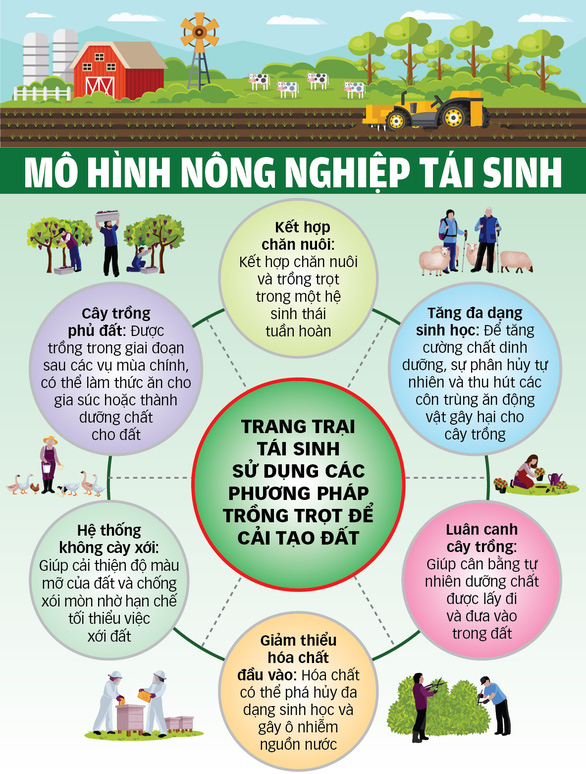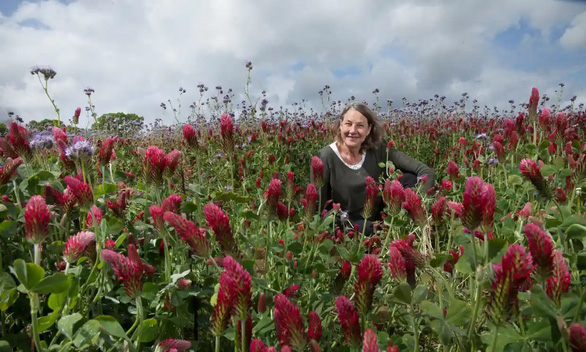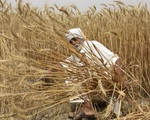Solutions for regenerative agriculture

Regenerative agriculture is often referred to as a farming method that improves soil and water retention, reduces tilling, uses less pesticides and fertilizers, stores more carbon in the soil and reduces emissions.
It also allows the farm to diversify crops and attract more wildlife. More and more farms want to adopt this approach in the face of rising costs of fertilizer, fodder and fuel.
Reborn from the wasteland
From the top of the hill, Ms. Marina O’Connell can cover most of the 15ha Huxhams Cross (Huxhams) farm. She has spent more than 6 years converting the barren wasteland into a sustainable farm in the form of regenerative farming, according to the Guardian newspaper (UK).
Taking over the farm in 2015, Ms. O’Connell has now turned Huxhams into lush vegetable fields.
“In the past, the farm used chemicals and basically the soil was degraded. We spent 2 years to improve the soil ecosystem, the ecosystem of plants, animals and microorganisms in the soil,” said Ms. O. ‘ Connell said.
One of their first jobs was planning the workflow at Huxhams, planting trees, planting rows of shrubs across steep hills, and installing a rainwater collection system.
They grow beans and clover and graze animals to add “green manure” to the soil before vegetables and fruits are planted. The chicken coops are moved around Huxhams weekly while the 2 cows become… lawn mowers.
According to Mrs. O’Connell’s experience, if the farm is large, the owner can renovate each part instead of doing it all to avoid too much financial expense.
Looking back at the results after the first 5 years, Huxhams stored about 5 tons of carbon per year. The biodiversity of the farm also increased, the number of insect species increased by 400% and the number of bird species increased by 30%.
The fruits, vegetables, eggs and wheat here are feeding 300 families a week. Huxhams is financially self-sufficient with 9 employees and profits from the sale of agricultural products.

Marina O’Connell in a flower field at Huxhams Cross farm – Photo: The Observer
Promoting biodiversity
Nikki Yoxall, 34, a farmer pursuing regenerative agriculture in Aberdeenshire, Scotland, says it is a type of farming that is easy to do for new entrants due to the low cost of inputs and equipment. hook.
The method has also boosted biodiversity and profitability when applied in small vineyards in Spain and later spread to olive groves.
In 2016, with financial support from the EU’s Life program, 20 olive farms in the province of Jaén, southern Spain were selected to convert to a regenerative agriculture model that allows grass and wildflowers to emerge among the crops. rows of olive trees.
Researchers at the University of Jaén found that three years after the transition, bee populations in 20 regenerated olive farms increased by 47 percent, birds by 10 percent and shrubs by 172 percent compared to 20 other olive farms. in the region.
“What we’re doing is going back to traditional methods. No tilling between the rows of trees helps to hold water better, and is less prone to erosion and washout after heavy rains. Vegetation makes the ground like sponges and trap rainwater,” said Paco Montabes, who grows 650 hectares of olives in the Sierra Mágina region, Jaén province.
In addition, with regenerative farming, olive growers can save money on pesticides and herbicides, as well as sell olive oil at a higher price.
“Farmers are at the forefront of climate change, we’re seeing more extreme weather systems. So it’s important to build resilient systems to overcome these problems and make rich environment,” said Mr. Brett Israel, 25 years old.
Mr. Israel switched to regenerative farming 6 years ago, according to CBC (Canada). His organic pig farm in Wallenstein, Ontario, Canada also rotates about 20 different crops.
Zero net emissions by 2040
The UK’s National Farmers Union (NFU) has ambitions to hit its net zero-emissions agricultural production target by 2040. NFU says its members are working harder to use the land in a way climate friendly.
According to the NFU, there are currently about 2,000 farms, covering more than half a million hectares of farmland in the UK, applying regenerative farming techniques.
Proponents of regenerative agriculture believe such systems can feed Britain without problems, as long as people eat a diet of more vegetables and less meat.
at Blogtuan.info – Source: tuoitre.vn – Read the original article here




